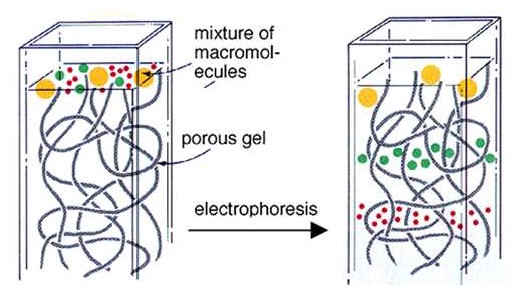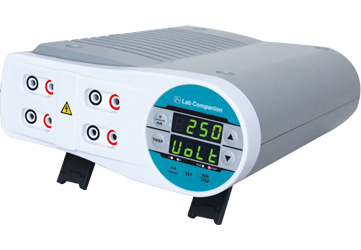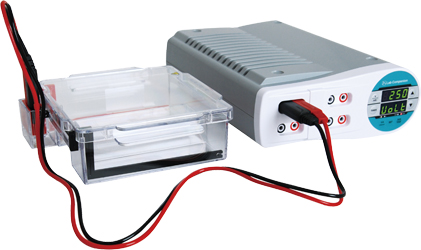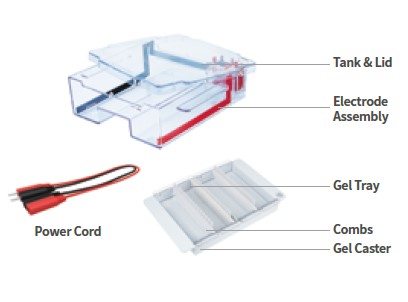Electrophoresis using agarose gel is a standard method to research biopolymers' features and use its separation and analysis. The basic principle is that nucleic acid (DNA, RNA) has its negative charges so that it can move under the electric field state. You might consider that electrophoresis is a simple method using a simple principle, but maybe you fail if you don't keep a basic. We introduce which points you should consider for the successful electrophoresis test.
1. Make a gel having a proper concentration.
Agarose gel commonly used in electrophoresis acts like a net

Fig 1. Movement of nucleic acid in an agarose gel
As you see in the above picture, the smaller DNA (that means a smaller number of DNA base pairs, kb) can move far away because it passes the agarose gel easier than the bigger DNA. So that is important to make an agarose gel with a suitable concentration that matches the DNA size you want to separate. For example, do electrophoresis for the big-size DNA in an agarose gel with a tight net due to the high concentration. You will see that almost all samples stay around the loading well because of the low mobility of DNA.
| DNA Separation range (kb) |
Agarose gel concentration (% W/V) |
| 5 - 60 |
0.3 |
| 1 - 20 |
0.6 |
| 0.8 - 10 |
0.7 |
| 0.5 - 7 |
0.9 |
| 0.4 - 6 |
1.2 |
| 0.2 - 3 |
1.5 |
| 0.1 - 2 |
2.0 |
Table 1. Proper agarose gel concentration according to DNA separation range.
Also, a point to improve the band resolution is to make a uniform gel. Stir well when you make the agarose gel spread agarose particles in a buffer solution, and be careful not to create air bubbles during hardening.
2. Use a proper buffer solution.
It needs a carrier with positive charges to move DNA with negative charges in an electric field. A buffer solution can do that. TAE (Tris-acetate, EDTA) and TBE (Tris-borate, EDTA) are usually used in the buffer solution. TBE buffer is better for a resolution in a gel than TAE buffer, so TAE prefers to use for the big-size DNA electrophoresis, and for the small-size DNA, it prefers TBE. Sometimes you might mistake using distilled water to make the agarose gel. Be sure to use a buffer solution with the same concentration in a running tank for creating a gel.
3. Supply the stable voltage.
You made the proper gel and finished the sample loading into a well with the appropriate buffer solution. Then the next step is to supply the voltage using the power supply. The moving speed is getting faster depending on the high loaded voltage, so the proper voltage should be decided according to DNA size and structure. Also, if the supply of voltage is not stable, the finished band is not clear after finishing the test. The worst case is the transmutation of samples, so be sure to keep attention to supply the voltage in a stable during the test. And make sure to check the electrode connection is correct to positive (+) and negative (-) before you supply the voltage.
EP&EPS of Lab Companion
EP and EPS of Lab Companion make your electrophoresis experiment more correct, fast, and convenient.

EPS-300

Connection to Power Supply
There is a level marker on the gel tray and a spirit level on the gel caster to make a flat and uniform gel, enhancing the reproducibility for the repeated test. And EP provides the comb (31 & 16well comb), which has the same spacing with the multi pipettes to load many samples at one time. For EP-18, the gel tray can be equipped with six combs in max, and then the gel can be cut after hardening to make some pieces of them. It makes the user save his own time. When the gel hardens, the user moves the whole gel tray as it has the gel. There is a tray position as a protruding shape in a tank so that the user can insert it. (except for EP-05.) The gel tray is UV through, so the user feels convenient that it does not need to remove the gel from the tray to move to the UV transilluminator to analyze the result. The power cord is classified with Black and Red color to easily recognize which electrode is positive or negative to prevent the connection mistake. And the end of them can be linked or separated, and this structure makes easy arrangement.

EP product composition
EPS is a power supply of Lab Companion; it has a wide output range from 5 to 250V to use mostly the experiment in molecular biology labs such as the size or quantitative analysis of DNA and RNA, or western blot. EPS can take up to 4 sets of EP at once, and the products of other companies are available to use as well. EPS provides two kinds of operation modes for the user's convenience - constant voltage and constant current. Especially when it connects to LC Connected service (option), remote monitoring is available on your mobile application. When it occurs the voltage supply problem, it sends an alert immediately to continue the stable experiment. This feature is helpful to do a test in a cold room because the user doesn't need to go there directly to monitor the state of voltage or current or to change any setting value.
>> More Information
| 






